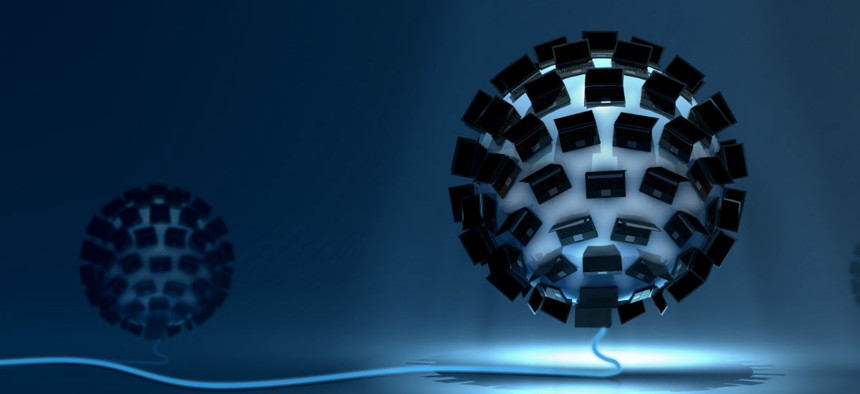Beyond the Black Box: Quantum Computing Explained

Damiano Poli/Shutterstock
Quantum computers break the laws of Newtonian physics by tapping into the science of quantum physics.
John Breeden II is an award-winning journalist and reviewer with over 20 years of experience covering technology and government. He is currently the CEO of the Tech Writers Bureau, a group that creates technological thought leadership content for organizations of all sizes. Twitter: @LabGuys
In my previous Nextgov column, I pointed out the National Institute of Standards and Technology program designed to preemptively protect government encryption from the possible threat of quantum computing. Since then, several people have written to ask me a logical follow-up question: “What is quantum computing?”
And while the question is logical, the answer may not be, at least in terms of how most of us normally perceive the universe.
At a very high level, quantum computers and their digital cousins like the desktops, phones and tablets you are using right now are similar. They are machines designed to accept programs and solve problems. How they go about that, however, couldn’t be more different.
» Get the best federal technology news and ideas delivered right to your inbox. Sign up here.
Digital computers use circuits either on or off, represented by a one or a zero in binary code. By sending information from programs that turn those circuits on and off, problems can be solved. But it can be a slow process.
Imagine you were confronted with a locked door and had millions of identical-looking keys on your ring, with only one that worked. Using the digital computer method, you would have to try each one, one at a time, until you found the right one.
Adding more circuits could increase your computing power, but you would still be stuck in the laws of physics and forced to try one key at a time. No matter how quickly you tried, it could still be a very long time before you got through.
Quantum computers, by contrast, break the laws of Newtonian physics by tapping into the science of quantum physics. In quantum physics, objects can exist in multiple states at the same time when you get down to the molecular level.
A quantum computer attempts to tap into those strange properties at the molecular level and harness them to solve problems at the macro level where we all live, or at least where we perceive reality.
To most people, quantum computers seem pretty alien. Even many computer scientists considered them to be complete hokum for a long time, and some still do. What makes them special is that instead of circuits, they use atoms or elections called quantum bits or qbits.
The qbits can exist in a state called superposition where they represent a one and a zero, and all states in-between—at the same time. Quantum computers then attempt to string together qbits so they can be compared and correlated.
National Science Foundation theoretical physicists John Preskill and Spiros Michalakis do a very good job of explaining how quantum computers are able to do this.
Now, you might be wondering, as we are all made up of these same atoms being used by quantum computers, why we don’t exist in multiple states at the same time, too?
The reason is that the state of superposition is very fragile. Almost anything can strip away those properties and imprison our atoms in the single state we call reality, which is probably a good thing for us. Beams of light, heat, soundwaves, vibration, air molecules or even radiation strip away the multiple states in a process called decoherence.
Quantum computers need to eliminate decoherence in order to induce superposition in their qbits. That is why they are built inside black boxes where no light or sound can penetrate. They are also shielded from radiation, kept in a vacuum and chilled down to almost absolute zero.
And you can’t even observe or monitor them as they work because any data leakage kills whatever equation they are working on. This also prevents any recording or analysis of their process, so you never really know how they arrived at their answer.
So you can understand why some people believe quantum computers are a big hoax costing the government billions. From the outside, it almost seems like the Wizard of Oz, with the all-powerful wizard, or black box, solving all our problems in secret. We want to unmask the man behind the curtain, only he doesn’t exist.
However, quantum computers do exist. The Defense Advanced Research Projects Agency, NSF, NASA, several universities and even a few private companies have one, and they are getting more powerful all the time, as is our understanding of how to program and use them.
Which brings us back to the problem of the keys and the lock from before.
While the digital computer might still be trying each key one at a time, a powerful quantum computer could instead use superposition to try all the keys at the same time and instantly open the lock. It doesn’t even really matter how many possible keys exist. That’s bad news for encryption, and why NIST is so worried about protecting government secrets by trying to develop some type of quantum-resistant defense.
We aren’t there yet, but many predictions have very powerful quantum computers coming online by 2025 or so. It will be interesting to see how they are designed, and what kinds of previously unsolvable problems or concepts this new technology will be able to explain.






